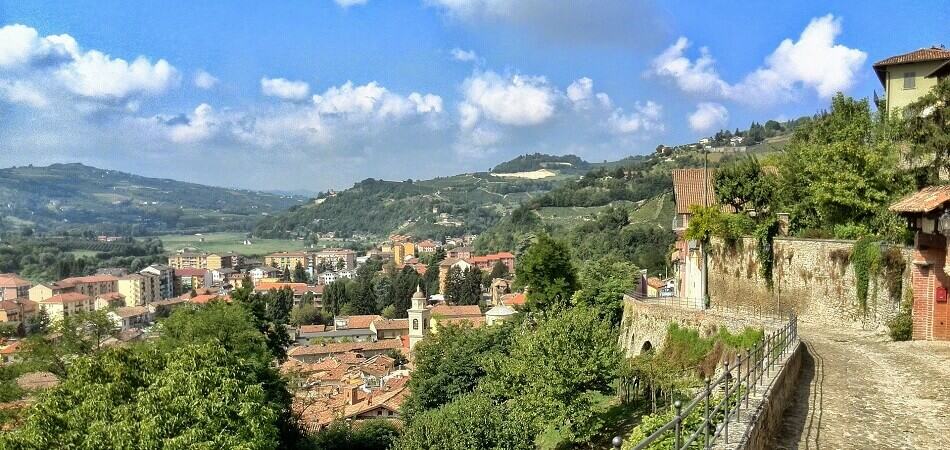Moscato is an Italian wine made from a family of grapes with the same name. The most common type is Moscato d’Asti, a white semi-sparkling wine that is sweet and has a low alcohol content.
There are also full-sparkling, red, rosé, and dry variations. They are less popular than Moscato d’Asti but nevertheless very good wines that are worth trying. In this article, we will discuss all of them.
WHAT IS MOSCATO WINE MADE FROM?
To produce Moscato wines, vintners use grapes from the Moscato family. In total, more than 200 single varietals of all colors belong to this varietal category. The most noteworthy among them are:
- Moscato Bianco (also: Muscat Blanc à Petits Grains, Moschato, Muskateller) is a white grape. You can find significant quantities of Moscato Bianco in Italy, France, Spain, Portugal, and the United States. But vintners in many other countries all around the world grow them as well.
- Muscat of Alexandria is a sweet white varietal for dessert wine production. As it has a high resistance to heat and drought, it fits hots climates. Winemakers cultivate it in regions at the Mediterranean Sea as well as in South Africa, California, and Chile.
- Moscato di Amburgo (English: Muscat of Hamburg, Black Muscat) is a red varietal that is also popular for dessert wine production.
- Moscato Fior d’Arancio (English: Orange Blossom Muscat, Orange Muscat) is a white grape.
DIFFERENT TYPES OF MOSCATO WINE
Moscato wines come in several different styles. They go through different production processes, and as a result, they differ in color, sweetness, and fizzyness. Most of them share the typical Moscato fruity flavors: citrus, peach, mandarine, and honeysuckle.
Moscato d’Asti
Moscato d’Asti is the most popular Moscato style. It’s a semi-sparkling (Italian: frizzante) white wine. Vintners use only the healthiest and ripest Moscato Bianco grapes to make it. The result is a high-quality sweet beverage.

Moscato d’Asti
Asti Spumante
Asti Spumante (short: Asti) is the full sparkling version of Moscato d’Asti. Like its semi-sparkling sibling, it is a sweet beverage made from Moscato Bianco grapes. It comes from Asti in Northern Italy and enjoys protection from the region’s DOCG status. However, it has never gained a reputation as high as Moscato d’Asti.
Pink Moscato
Pink Moscato has a color similar to Rosé wine, although it technically is not Rosé. Instead, it’s a blend of white Moscato Blanc and red Merlot grapes. It comes with typical fruity Moscato flavors like peach or citrus. In addition, it can contain notes of strawberry, vanilla, and caramel. Pink Moscato can be still or sparkling.
Red Moscato
A red variation of Moscato wine is made from Black Muscat and Orange Muscat grapes. It’s more intense in flavor than white wines with a broader range of tastes. While it still has the usual Moscato flavors, it also offers aromas of raspberries, strawberries, and cherries, but also floral notes.
Moscato Dessert Wine
Many winemakers around the world produce dessert wines from Moscato grapes that are even sweeter than Moscato d’Asti. Among them are:
- Muscat de Beaumes de Venise from Southeast France,
- Moscatel de Setúbal, a honeyed fortified wine from Southern Portugal,
- Muscat de Samos, a golden wine from the Greek island of Samos,
- Rutherglen Muscat from Australia which comes in various styles and quality levels,
- Moscatel Sherry, which vintners produce in different parts of Spain.
HOW MOSCATO D’ASTI IS MADE
It’s hard to cultivate Moscato Bianco grapes. They require a long growing season on the hillsides of Asti because they ripen late in the year. During this time, the grapes are very vulnerable to pests and diseases like grey rot, mildew, or berry moths. And even if they make it to the harvesting season in September, when the grapes contain the optimal level of sugar, they tend to produce only low yields. Thus, winegrowers need to invest a lot of time and care into cultivating Moscato.
After the harvest, vintners have to crush and press the grapes immediately so they are still fresh. Both harvesting and crushing take place without any modern technology. Workers pick the grapes by hand and use manual presses to squeeze the juice out of them gently.
At this point, winemakers would typically start fermenting all of the wine must they press out of the grapes. But those who make Moscato d’Asti don’t. Instead, they cool down most of the wine must to temperatures close to the freezing point. The reason is simple: Unlike other wines, Moscato d’Asti is produced all year long. So winemakers process only small batches of their must directly after the crushing and keep the rest to finish it later in the year. The refrigeration prevents the must from fermentation and also preserves the typical Moscato aromas.
When they are ready to start the fermentation, winemakers transfer the wine must into stainless steel tanks. Then, they raise the tanks’ temperature to about 60 degrees Fahrenheit (15°C). As the tanks are sealed, the CO2 released during this process can’t escape and stays inside the wine. This production process is characteristic of Moscato d’Asti and its fizzyness, and thus, it’s called the Asti Method.
As soon as the wine reaches its desired alcohol content of 5.5%, winemakers chill it down to stop the fermentation. After filtering out the remaining yeast and bottling and corking the wine, it is ready for sale.
How Asti Spumante Is Made
The first phase of Asti’s production process is similar to how Moscato d’Asti is made: Vintners pick and crush the grapes manually, chill down the must, and process it in small badges throughout the year. But for Asti, they stop the fermentation later than for Moscato d’Asti. This means that more sugar turns into alcohol, and more CO2 is produced. The result is a full sparkling wine with 7 to 9% alcohol.
WHAT DOES MOSCATO WINE TASTE LIKE?
Moscato d’Asti is a semi-sparkling wine, so it’s less fizzy than Champagne or Prosecco, and significantly lower in alcohol. Typically, it’s sweet and has a significant acidity that balances this sweetness greatly. It offers a complex bouquet of fruity aromas, especially citrus, orange, apricots, and tropical fruits.
Pink Moscato tastes similar to Moscato d’Asti and provides the same bubbly experience. But it contains additional flavors of vanilla or caramel. You might also sense notes of red berries, cherries, or pomegranates.
In red Moscato, you can find aromas of red berries as well, but more intense than in pink Moscato. It combines flavors of strawberry, raspberry, or black cherries with the typical notes of citrus fruits you can find in all Moscato wines. The alcohol level and sweetness of red Moscato are comparable to its white and pink siblings.
The flavors of Asti Spumante are very similar to those of Moscato d’Asti. But as Asti is a full-sparkling wine, it provides a more fizzy experience. Besides, it’s also stronger in alcohol. While Moscato d’Asti can’t have more than 5.5%, Asti Spumante contains between 6 and 9%, typically around 7.5%.
The taste of still Moscato wine differs a bit more from the other Moscato types. Its complex aromas trick your brain into believing it’s a sweet wine as well. But when drinking it, you will find out that it’s much drier than Moscato d’Asti. It also has a higher alcohol content of up to 12%.
Moscato dessert wines offer intense flavors of cotton candy, candied apples, and cinnamon. You might also sense floral aromas. These fortified wines are stronger in alcohol. For instance, Black Muscat wines typically contain around 15% alcohol.
WHERE DOES MOSCATO COME FROM?
Moscato Bianco comes from Italy. It’s one of the oldest grapes in Europe, and it’s grown for hundreds of years in the Piedmont region in Northern Italy.

Historically, Moscato d’Asti was the wine that winemakers made for themselves. Due to its low alcohol content, they could drink it during their lunch breaks without negatively affecting their work performance. It was also a constant part of the traditional multi-course dinner, typically as a digestif before the dessert.
In the late 19th century, Moscato d’Asti became popular among the general population. Since then, it has earned a reputation as a high-quality dessert wine. In 1967, the region of Asti gained the status of a DOP and was promoted to DOCG in 1993.
In the last decade, wine experts could see an enormous boost in the popularity of Moscato d’Asti, particularly in the United States. Sales numbers have jumped by 10 to 15% per year since 2011. One reason might have been the numerous references to Moscato wines in rap songs, for example, by musicians like Lil’Kim, Drake, or Kanye.
The boost in sales encouraged American winemakers to produce their own Moscato wines. As a result, you can nowadays find Moscato (which is not a protected term in contrast to Moscato d’Asti) from California, New York, and Washington State.
HOW TO SERVE MOSCATO WINE
Moscato wines are very versatile. You can serve them as aperitifs before dinner, as pairings to accompany specific courses, or to sip on their own. Especially the sparkling and semi-sparkling versions are great drinks for celebrations. You can serve them at garden parties, stand-up receptions, or weddings, just like Champagne. You might even like them for brunch. Finally, a Moscato dessert wine is a fabulous digestif as well.
What Is the Right Glass for Moscato Wine?
There is no such thing as a specific Moscato glass. Thus, you should pick the glasses for serving Moscato according to its specific type:
- For all sparkling Moscato wines, including Moscato d’Asti and Asti Spumante, go for a Champagne flute. These tall, thin glasses preserve the bubbles longer than regular wine glasses.
- For still white Moscato, pick a regular white wine glass with a wide opening. These glasses guide the wine to the right parts of your tongue so you can perceive its delicious sweetness.
- A Burgundy glass or a regular red wine glass is the right option for still red Moscato.
- Serve Moscato dessert wines in Port glasses or similar dessert wine glasses with small bowls.
What Is the Right Serving Temperature for Moscato Wine?
In general, you should serve Moscato wines chilled. But depending on the exact style, you can vary the serving temperature:
- Serve Moscato d’Asti and Asti Spumante at around 43°F (6°C) to keep their bubbles fresh.
- For still Moscato and pink Moscato, aim slightly higher. Temperatures between 45 and 47°F are fine (7-8°C).
- Red Moscato is excellent at 50°F (10°C).
- Moscato dessert wine is delicious when it has between 60 and 70°F (15-21°C).
Should You Decant Moscato Wine?
You should never decant Moscato d’Asti and Asti Spumante before drinking. Leaving them open and exposed to air will cause the CO2 to disappear and kill the bubbly experience.
Still Moscato wine will not suffer from decanting, but it won’t benefit from it significantly either. Better consume it right away to enjoy its freshness.
HOW TO STORE MOSCATO WINE
Probably the most important characteristic of Moscato is its freshness. To preserve this freshness, you should keep Moscato bottles in a cool, dark place away from heat or sunlight. Also, make sure that you don’t expose it to significant temperature changes. A temperature of 55°F (13°C) maximum is fine. Store the bottles horizontally, so their corks don’t dry out.
Can Moscato Be Aged?
Moscato wines aren’t age-worthy. They won’t get better if you store them in your cellar for years. Thus, you should consume them soon after buying them.
Can Moscato Go Bad?
Moscato wines can go bad when mistreated. Exposure to sunlight or heat will damage their flavors. Moscato d’Asti or Asti Spumante are even more vulnerable. If they lose their delicate bubbles, they get dull and unenjoyable.
How Long Does Moscato Last When Open?
Moscato wines have a rather short lifespan after you open them. When stored in a fridge, they last for about a week. Especially the sparkling styles should be consumed sooner rather than later.
WHICH FOOD GOES WITH MOSCATO?
Due to its versatility, Moscato is a great match for a surprisingly high number of foods. The sweet styles go well with dishes with opposite flavor profiles: salty, sour, spicy, or bitter.
For instance, Moscato is a great pairing for salty cured meat specialties like Salami, Prosciutto, Chorizo, or Jamón Ibérico. But you can also serve it with nuts, almonds, and similar snacks.
If you prefer more healthy snacks, go for a plate of raw vegetables with dips. Crunchy carrots, celery, bell peppers, and radishes match greatly with Moscato d’Asti or Asti Spumante. The same goes for light lunches like salads, chicken, or seafood.
The sweetness of Moscato also balances the intense flavors of spicy dishes perfectly, no matter if still or sparkling. That’s true for basically any dish that contains ingredients like garlic, ginger, cardamom, chili, cinnamon, fennel, or marjoram. Try the sweet styles with Asian food like Teriyaki Chicken, Hoisin Duck Noodles, Garlic Chili Shrimp, or dishes with peanut or cashew sauces. Alternatively, drink them with a southern BBQ or with Cajun cuisine.
Finally, Moscato goes well with most kinds of desserts, as long as the dessert isn’t too sweet. Chocolate-based dishes typically overpower the wine. But pairing Moscato with fruit-based dishes like fruit salads, berry pies, or fluffy cakes with fruit toppings works perfectly. Especially the red and rosé variations match these desserts.
Finally, you can enjoy these Italian wines with cheese.
Serve a glass with soft cheeses like Camembert and Brie or with strong blue cheeses like Gorgonzola, Roquefort, and Stilton.
SHOPPING TIPS FOR MOSCATO WINES
As mentioned before, Moscato d’Asti and Asti Spumante are protected names. So when you’re looking for the original taste from Italy, look out for bottles that carry these names. Be aware that many winemakers don’t use the term Spumante (English: Sparkling Wine) on their labels anymore. So they call their sparkling wine simply “Asti”.
For entry-level wines, expect to pay around 15 USD for a bottle of 750ml:
- type: white, sparkling
- origin: Piedmont, Italy
- varietal: Muscat
- alcohol: 5.0%
- type: white, sparkling
- origin: Piedmont, Italy
- varietal: Muscat
- alcohol: 7.5%
- type: white, sparkling
- origin: Piedmont, Italy
- varietal: Muscat
- alcohol: 7.5%
- type: white, semi-sparkling, Vintage
- origin: Piedmont, Italy
- varietal: Muscat
- alcohol: 6.0%
Vietti Moscato d'Asti Cascinetta 2020
- type: white, semi-sparkling, Vintage
- origin: Piedmont, Italy
- varietal: Muscat
- alcohol: 5.5%
- type: white, semi-sparkling, Vintage
- origin: Piedmont, Italy
- varietal: Muscat
- alcohol: 6.0%
High-quality Moscato d’Asti costs about 50 USD. Moscato wines from the United States are typically more affordable. You can find decent wines for prices as low as 6 USD.
FINAL WORDS
Moscato wines belong to the most versatile types of wines. They are great matches for many different occasions and also for many kinds of food. You should have a bottle or two in your wine cellar at any time so you are prepared to serve it at your next garden party.






